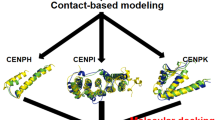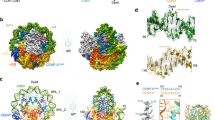Abstract
Human centromere protein C (CENP-C), a chromosomal component of the inner plate of kinetochores, was originally identified as one of the centromere auto-antigens. In a previous study, we showed that it possesses DNA-binding activity in vitro. Recently, centromere-binding activity was suggested at the C-terminal region in vivo. However, little is known about the role of CENP-C in kinetochore organization. Here, to characterize its biochemical properties, three separate antigenic regions of human CENP-C were expressed in Escherichia coli, affinity purified and used in South-western blotting and chemical cross-linking analyses. We found that the internal DNA-binding domain was composed of two kinds of elements: the ‘core’ and two flanking ‘stabilizing’ elements that support the activity. When cross-linked with disuccinimidyl suberate (DSS), the N-terminal region produced the ladder bands of dimerand tetramer: the C-terminal region exclusively produced the dimer band, whereas the internal region was not affected at all. Dimer formation at the C-terminus in the native state was also indicated by gel filtration and the presence of conformation-specific autoantibodies in the patient's sera. These results suggest that human CENP-C consists of three functional units required for ‘kinetochore assembly’: a putative N-terminal oligomerization domain, an internal DNA-binding domain and a C-terminal dimerization domain.
Similar content being viewed by others
References
Brenner S, Pepper D, Berns MW, Tan E, Brinkley BR (1981) Kinetochore structure, duplication, and distribution in mammalian cells: analysis by human autoantibodies from scleroderma patients. J Cell Biol 91: 95–102.
Brown MT (1995) Sequence similarities between the yeast chromosome segregation protein Mif2 and the mammalian centromere protein CENP-C. Gene 160: 111–116.
Cooke CA, Bernat L, Earnshaw WC (1990) CENP-B: a major human centromere protein located beneath the kinetochore. J Cell Biol 110: 1475–1488.
Cooke CA, Bazett-Jones DP, Earnshaw WC, Rattner JB (1993) Mapping DNA within the mammalian kinetochore. J Cell Biol 120: 1083–1091.
Cornell R (1989) Chemical cross-linking reveals a dimeric structure for CTP: phosphocholine cytidyltransferase. J Biol Chem 264: 9077–9082.
Earnshaw WC, Rothfield N (1985) Identification of a family of human centromere proteins using autoimmune sera from patients with scleroderma. Chromosoma 91: 313–321.
Kim S, Willison KR, Horwich AL (1994) Cytosolic chaperonin subunits have a conserved ATPase domain but diverged polypeptide-binding domains. Trends Biol Sci 19: 543–547.
Kitagawa K, Masumoto H, Ikeda M, Okazaki T (1995) Analysis of protein-DNA and protein-protein interactions of centromere protein B (CENP-B) and properties of the DNA-CENP-B complex in the cell cycle. Mol Cell Biol 15: 1602–1612.
Lanini L, McKeon F.(1995) Domains required for CENP-C assembly at the kinetochore. Mol Biol Cell 6: 1049–1059.
McKay S, Thomson E, Cooke H (1994) Sequence homologies and linkage group conservation of the human and mouse cenpc genes. Genomics 22: 36–40.
Masumoto H, Masukata H, Muro Y, Nozaki N, Okazaki T (1989) A human centromere antigen (CENP-B) interacts with a short specific sequence in alphoid DNA, a human centromeric satellite. J Cell Biol 109: 1963–1973.
Moroi Y, Peebles C, Fritzler MJ, Steigerwald J, Tan EM (1980) Autoantibody to centromere (kinetochore) in scleroderma sera. Proc Natl Acad Sci USA 77: 1627–1631.
Muro Y, Sugimoto K, Okazaki T, Ohashi M (1990) The heterogeneity of anticentromere antibodies in immunoblotting analysis. J Rheumatol 17: 1042–1047.
Page SL, Earnshaw WC, Choo KHA, Shaffer LG (1995) Further evidence that CENP-C is a necessary component of active centromeres: studies of a dic(X;15) with simultaneous immunofluorescence and FISH. Hum Mol Genet 4: 289–294.
Pilch P, Czech MP (1980) The subunit structure of the high affinity insulin receptor. J Biol Chem 255: 1722–1731.
Rieder CL (1982) The formation, structure, and composition of the mammalian kinetochore and kinetochore fiber. Int Rev Cytol 79: 1–58.
Saitoh H, Tomkiel J, Cooke CA et al. (1992) CENP-C, an autoantigen in scleroderma, is a component of the human inner kinetochore plate. Cell 70: 115–125.
Sugimoto K (1994) DNA immunoprecipitation: application to characterization of target sequences for a human centromere DNA-binding protein (CENP-B). In: Celis JE, ed. Cell Biology: A Laboratory Handbook. San Diego: Academic Press, pp 335–343.
Sugimoto K, Muro Y, Himeno M (1992) Anti-helix-loop-helix domain antibodies: discovery of autoantibodies that inhibit DNA binding activity of human centromere protein B (CENP-B). J Biochem 111, 478–483.
Sugimoto K, Hagishita Y, Himeno M (1994a) Functional domain structure of human centromere protein B: implication of the internal and C-terminal self-association domains in centromeric heterochromatin condensation. J Biol Chem 269: 24271–24276.
Sugimoto K, Yata H, Muro Y, Himeno M (1994b) Human centromere protein C (CENP-C) is a DNA-binding protein which possesses a novel DNA-binding motif. J Biochem 116: 877–881.
Sugimoto K, Yamada T, Muro Y, Himeno M (1996) Humanhomolog of Drosophila heterochromatin-associated protein 1 (HP1) is a DNA-binding protein which possesses a DNA-binding motif with weak similarity to that of human centromere protein C (CENP-C). J Biochem 120: 153–159.
Tomkiel J, Cooke CA, Saitoh H, Bernat RL, Earnshaw WC (1994) CENP-C is required for maintaining proper kinetochore size and for a timely transition to anaphase. J Cell Biol 125: 531–545.
Verheijen R, de Jong BAW, Oberye EHH, van Venrooij WJ (1992) Molecular cloning of a major CENP-B epitope and its use for the detection of anticentromere autoantibodies. Mol Biol Rep 16: 49–59.
Yang CH, Tomkiel J, Saitoh H, Johnson DH, Earnshaw WC (1996) Identification of overlapping DNA-binding and centromere-targeting domains in the human kinetochore protein CENP-C. Mol Cell Biol 16: 3576–3586.
Author information
Authors and Affiliations
Rights and permissions
About this article
Cite this article
Sugimoto, K., Kuriyama, K., Shibata, A. et al. Characterization of internal DNA-binding and C-terminal dimerization domains of human centromere/kinetochore autoantigen CENP-C in vitro: role of DNA-binding and self-associating activities in kinetochore organization. Chromosome Res 5, 132–141 (1997). https://doi.org/10.1023/A:1018422325569
Issue Date:
DOI: https://doi.org/10.1023/A:1018422325569




